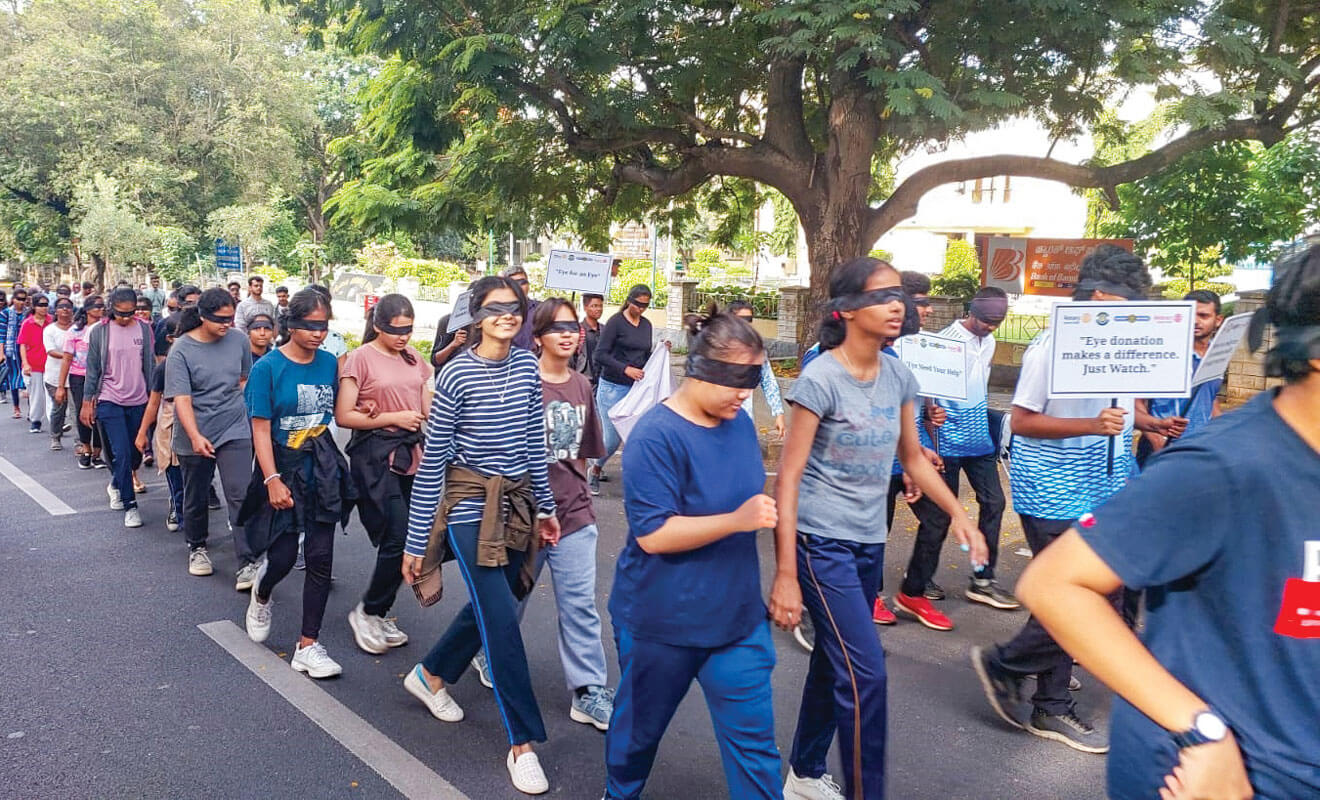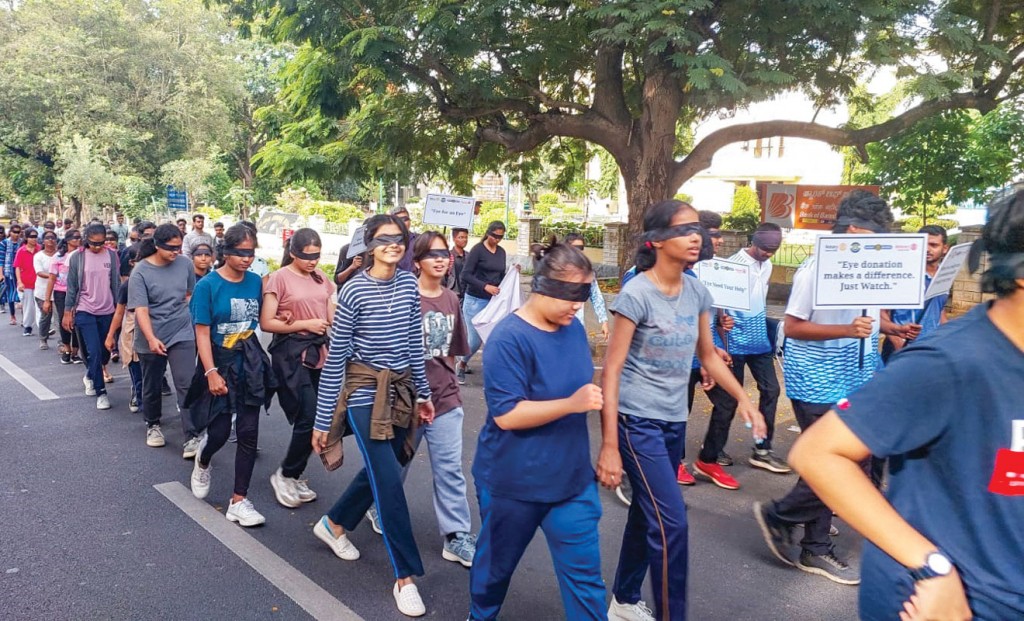It was a walk by about 300 people to raise awareness on the plight of the visually-challenged and to stress the importance of organ donation, especially pledging of one’s eyes, but it was done with a difference. The walk, organised by RC Panchsheel Mysore and RC Mysore, RI District 3181, in association with the Rotary Avoidable Blindness Foundation, had the visually-challenged leading the march, and was held during the National Eye Donation Fortnight.

Rotarians, Rotaractors, college students, and other sighted people, including RI Director Anirudha Roychowdhury, walked behind, but with blindfolding. They were following the lead given by the visually-challenged carrying white canes. The idea was to make the sighted people understand the difficulties faced by the blind.
President of RC Panchsheel Mysore, Kiran Robert, said that the two clubs’ members wanted to organise a walk during the National Eye Donation Fortnight (Aug 25–Sep 8) “not only to raise awareness about the importance of eye donation and how easy it is to pledge one’s eyes, but also to debunk many myths that surround eye donation.”

Giving an example of the huge extent of the problem in India and the demand for corneas being much greater than the supply, he said there are over 20,000 new cases of blindness every year in India due to eye injuries, Vitamin A deficiency, infections, malnutrition, and many other medical problems. These people can regain their sight by corneal transplantation and the “most significant thing about eye donation is that a single pair of eyes can often help four people regain their vision.” (There is established medical finding that optimum and efficient use will ensure that a single corneal tissue can be successfully used for two patients as a routine practice and restore their vision.)
But sadly, added Robert, despite the central and state governments launching many campaigns for eye donation, this practice of pledging one’s eyes had not really caught on in India. “For instance, over 10 million deaths happen every year in India but we are collecting only around 50,000 pairs of eyes every year through eye donation. So our club leaders thought it fit to focus attention on this dilemma and use our vast Rotary network to increase public awareness on the greater good we can do after we pass on. After all, aren’t we Rotarians connected by a strong sense of community, belonging and service?”
He added that their second objective is to create sight ambassadors, because unlike blood donation where one is in control while donating blood for somebody in need, in the case of the eye, the donor can only pledge his/her eyes, which can be harvested only after their death.

Most often there are several years between the eyes being pledged and actually donated so that they can be used to benefit those in desperate need of vision. “In their moment of grief, and the trauma that follows the death of a loved one, families tend to forget about the pledge. At that moment someone, such as an ‘eye ambassador’ among the dead person’s friends or family, needs to ensure that an eye bank is contacted and the eyes are harvested in time.”
(According to literature available with the Eye Banks Association of India, the eyes must be removed within six hours of death, so the alert has to be given to the nearest eye bank soon after death. A team from the bank will visit the house and ‘the simple bloodless procedure will be over in less than 15–20 min.’ There is no disfigurement of the face of the deceased. After removal, the eyes are analysed, processed at the eye bank and the cornea has to be transplanted within 96 hours.)
Those willing to donate their eyes must get registered at an eye bank, and the bank must be informed after the person’s death. Both the donor and recipient are kept anonymous.
Giving an example of what passion for any cause can achieve, Robert said that Dr J Ganesh of Sivakasi, who is a Lion’s club member, “has an unbeatable record of retrieving over 4,400 pairs of eyes, which have enabled over 16,000 blind people to get back their sight.”

Becoming a sight ambassador is simple; one needs to just send the SMS/text message ‘Eye’ to 70396 70396.
Returning to the 1km walk, which took about 45 minutes, Professor and HOD of the department of political science from Mysore University Krishna Hombal, who is visually-challenged, inaugurated the walk in which both the blind as well as the sighted, including some 15–20 policemen participated. A special group of 25 bikers, from the International Fellowship of Motorcycle Riders, led the blind walk.
Robert added that the Rotarians will not stop with just this walk to raise awareness on eye donation. “Now we want to develop eye retrieving centres; we’ve spoken to the deputy commissioner of Chamarajnagar, Shilpa Nag, an IAS officer, who is interested in this project to promote eye donation, and she said she would support this cause.” The first eye retrieval unit, costing around ₹20,000, will be set up at the public health centre in that area. “We will train volunteers for this task which is simple; we’ve tied up with the Usha Kiran Eye Hospital in Mysuru, from where doctors will train our volunteers on how to retrieve the eyes from a corpse.”
Once this is done successfully, they plan next to put up more — at least 10 — eye retrieval units in rural areas.
This group of Rotarians, he added, has long-term plans; and their ambition is to put up an eye bank. “Our objective is to have a Rotary eye bank in Chamarajnagar through a global grant project and Shilpa Nag, who is an honorary member of our club, has promised to help us.”
Apart from RID Roychowdhury and Kiran Robert, Praveen, president-elect, RC Mysore, DGs H R Keshav (RID 3181), Nasir Borsadwala (RID 3170), Dr Sunder Rajan (RID 3203), Udaykumar Bhaskara (RID 3191) and V Srinivas Murthy(RID 3192), Lion member Dr Ganesh from Sivakasi, Latha Narayan, a Rotarian from Tumkur, who has retrieved 2,400 eyes, participated in the walk.






